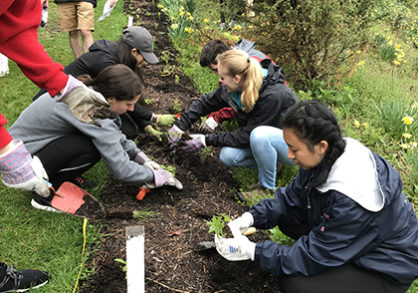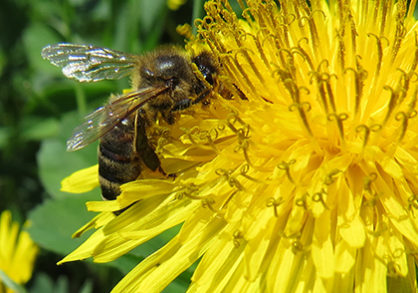Pollinators are in peril. We teamed up with staff at Cornell Botanic Gardens and researchers at pollinator labs on campus to come up with a four-part approach to address their decline:
Connect
The Botanic Buzzline, like other “pollinator pathways,” serves a dual function for pollinators—it provides food in the form of pollen and nectar, and a rest stop for insects during their travels. Presently, habitat destruction and industrial development pose serious issues for pollinators because they make it harder for them to get from flower to flower without running out of energy. Pathways such as ours help fix this problem by providing a road which pollinators can take to safely navigate from one flowering site to another, without running out of food along the way.
Protect
Pesticide use, invasive species, and foreign diseases are hurting both plant and pollinator populations alike. Pollinators have often spent thousands of years co-evolving one-of-a-kind pollination strategies with a single type of plant, so anything that impacts one member of this relationship also affects the other. Reckless pesticide use is a common, man-made contribution to pollinator-decline, so we decided to prepare our pathway for planting by using sheet-mulching instead of weed-killers.
Prepare
Climate change is seriously affecting weather systems in many areas, and not all plants are well-equipped to survive these new conditions. Typically, plants native to a specific area require less support than introduced plants, and so they may better withstand hard times when they occur. We included only native and naturalized plant varieties along the Buzzline so that they would require less external care and better support local pollinators. Also, timing of blooms each year can vary, so it is important to grow plants that flower early and provide shelter such as the previous year’s stems or bare ground for insects to nest in.
Educate
Finally, the most important aspect of the Buzzline is its role in educating visitors about pollinator decline. Individuals can—and do—make a significant difference for pollinator health in their communities by planting gardens or limiting their use of lawn care pesticides. Check out our “Tips for a Pollinator-Friendly Garden” page for more information on simple steps you can take to protect pollinators!
Inspiration on gardening with native pollinator plants at home can be found in this new resource, “Creating a pollinator garden for native specialist bees of New York and the Northeast.” Staff Gardener Krissy Boys, Field Botanist Robert Wesley, and volunteer Rosemarie Parker contributed to this guide authored by Maria van Dyke and Bryan Danforth. While most pollinator garden planting guides talk about generalist bees, such as honey bees, this new guide provides detailed information on gardening for the native, solitary bees that are critical to biological diversity and that depend on specific plants to raise their young. Published by the Pollinator Network @Cornell.
More About the Buzzline
Plant for Pollinators
These tips and resources can help you create pollinator-friendly outdoor spaces.
The Botanic Buzzline Story
Four Cornell students raised funds and coordinated the installation of the Botanic Buzzline.
Botanic Buzzline
This pollinator pathway was developed by four Cornell undergraduates to address pollinator decline in the Ithaca community.


